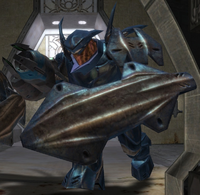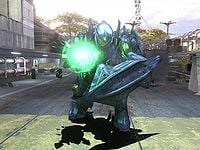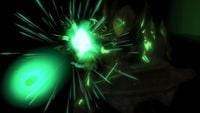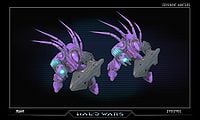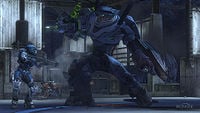Mgalekgolo/Gameplay: Difference between revisions
From Halopedia, the Halo wiki
BaconShelf (talk | contribs) mNo edit summary |
m (→Halo: Reach: Spelling, format, and grammar errors. Also, please try to follow the style of the rest of the article. Instead of talking about very specific scenarios like a specific mode on a specific map, give generally useful information.) |
||
| (One intermediate revision by one other user not shown) | |||
| Line 132: | Line 132: | ||
*The [[M6/V Spartan Laser]] is a very effective weapon, scoring a one-hit kill if aimed correctly. | *The [[M6/V Spartan Laser]] is a very effective weapon, scoring a one-hit kill if aimed correctly. | ||
*The Energy Sword is highly effective against Hunters, as each slash will stun them and a slash to the back kills them instantly on any difficulty. | *The Energy Sword is highly effective against Hunters, as each slash will stun them and a slash to the back kills them instantly on any difficulty. | ||
*The [[M45 shotgun]] can be used effectively against single Hunters in close quarters situations if the player circles around them while aiming for their weak spots. | |||
Hunters are even more dangerous than in previous games. Their Assault cannon is similar to the one for Halo: Combat Evolved. They will rarely aim directly at the player, instead shooting at their feet, relying more on the splash damage then the actual projectile. Melee attacks by Hunters are much faster and more powerful, making them much more difficult to engage in close quarters. In addition Armor Lock is disabled if struck by a Hunter. Hunters will also use their shields more efficiently than in previous games. They will often use their shield to protect their exposed midsection and necks when attacked, making attacks on the back section the only viable option to kill them. However attacks on their backs are difficult to accomplish if detected by the Hunter due to their high speed. Their increased health makes successful attacks on their back less damaging. They display much greater resistance to most forms of damage, capable of surviving rockets and Spartan Laser hits head-on on Heroic difficulty and higher. They are encountered rarely, but they are extremely dangerous on any difficulty. Furthermore, with Reach's revamped physics system, splattering them is near impossible, unlike in previous games. | Hunters are even more dangerous than in previous games. Their Assault cannon is similar to the one for Halo: Combat Evolved. They will rarely aim directly at the player, instead shooting at their feet, relying more on the splash damage then the actual projectile. Melee attacks by Hunters are much faster and more powerful, making them much more difficult to engage in close quarters. In addition Armor Lock is disabled if struck by a Hunter. Hunters will also use their shields more efficiently than in previous games. They will often use their shield to protect their exposed midsection and necks when attacked, making attacks on the back section the only viable option to kill them. However attacks on their backs are difficult to accomplish if detected by the Hunter due to their high speed. Their increased health makes successful attacks on their back less damaging. They display much greater resistance to most forms of damage, capable of surviving rockets and Spartan Laser hits head-on on Heroic difficulty and higher. They are encountered rarely, but they are extremely dangerous on any difficulty. Furthermore, with Reach's revamped physics system, splattering them is near impossible, unlike in previous games. | ||
Latest revision as of 18:33, April 29, 2024
| This article does not meet the wiki's general standards and/or standards on layouts. You can help by cleaning this article. |
Gameplay[edit]
Not many traditional weapons work well on the Hunters. Assault Rifles and Battle Rifles only work if you can sneak behind them, but if you get close enough, melee attacks to the unarmored orange section are best, even though none of these methods are 1-hit kills. If you try to sneak behind it, be careful, because as soon as it realizes you're behind it, it will give you a good whack with its shield. Dodging a Hunter's shield swing is easy. Simply step to the side, then behind them when the Hunter begins the attack. From this position, you can proceed with melee attacks to the exposed orange back, or shoot them in the exposed area with your weapon. When the Hunter turns around to smack you, simply jump back, and bait it to charge you again. Rinse and repeat. Long range weaponry and vehicles don't work well (except for a sniper rifle shot straight to exposed flesh), because of the hunters' fuel rod cannon (Sniper Rifles or Beam Rifles don't work well otherwise in the front because of the shield for the most part). Scorpions are the exception (excluding Halo Wars) and so are most explosives. Two Fuel Rod Cannons or Rocket Launchers or one Spartan Laser to any part of the body (besides the shield) will take down a Hunter. Gravity Hammers can also be used to attack a Hunter from either the front or rear, but this is risky because it can make you an easy target for the Hunter's melee. Trying to take down a Hunter by shooting him in the back is a last resort, as Hunters travel in pairs of two, giving the second Hunter an open shot at you. Another tactic against Hunters consists of getting close to them, and when the Hunter starts to chase you to hit you with it shields, you begin to fall back, all of this while firing continually with an Assault Rifle or Battle Rifle (not firing at the shield if you can). This tactic only works in closed areas and it requires a lot of bullets to kill a Hunter (approximately 90 rounds) if you don't hit the orange zone.
Combat[edit]
Halo: Combat Evolved[edit]
- Main article: Halo: Combat Evolved
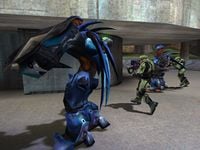
- Hunters fire heavy, exploding plasma projectiles that travel in an arc, similar to the shots fired from the Fuel rod gun.
- They can be killed in one shot from the M6D pistol or Sniper rifle if hit in their orange, weak spot.
- Their armor does not completely deflect projectiles, but merely reduces the damage they do to the Hunter.
- Hunters are smaller than in future games, standing at about 10 feet tall (8 feet when hunched over for combat).
- Hunters also have fewer melee combat maneuvers than in future games, and the moves they do have are somewhat slower.
A Mgalekgolo's armor is resistant to most small arms fire, and significantly reduces the damage they take from enemy projectiles (on Normal difficulty, a Hunter can still be killed with a few dozen pistol or plasma shots to the armor).
They do, however, have an exploitable weak spot which only requires a pistol shot to cause death: the exposed orange flesh located in their midsections and necks. While they keep the exposed areas on the fronts of their bodies well-covered with their shields, rarely giving the player an opening unless the Hunter tries to melee him, the creature's back has a large exposed area that is extremely vulnerable. If a rocket is fired at them, it does not matter where you are aiming, it will always kill the target with one shot (unless while playing on Legendary and sometimes Heroic mode, in which case it take as many as two rockets). Another tactic available is to shoot the green sections of their Assault cannon (only successful with the pistol).
While not on alert to an enemy's presence, they assume a stance where their neck and midsection is especially vulnerable, making for an easy 1 shot kill with a pistol or sniper.
Weapons such as the shotgun and sniper rifle work great for very short and very long distances respectively. Grenades are only moderately effective, as the Hunter could withstand a half-dozen grenade blasts. Plasma weapons (with the exception of the plasma rifle on lower difficulties) are generally ineffective, as is the needler. The MA5B Assault Rifle also typically takes too long to make a kill so other weapons are far more useful.
On Legendary, some players regarded Hunters as some of the most challenging enemies in the game. Inexperienced or careless players can fall victim to the Hunters' attacks, which, while easy to anticipate, are rather quick and powerful.
A unique way to kill a Hunter, is to melee it over and over again and can be done to the front of the Hunter; however, it is highly recommended to hit from behind, as it is easier for them to attack what's in front of them.
Another way to kill a hunter is to jump on the Hunter while he is doing a melee, and shoot the hunter's vulnerable back with a pistol, which would badly damage, if not kill, the hunter. However, often the range you jump would be so far that accurately shooting at the Hunter is difficult.
Hunters cannot ginger their enemies, unlike the later games. So the smart player would take advantage of that.
Hunters are, like all other enemies in Halo: Combat Evolved, extremely vulnerable to vehicle collisions. A Warthog can kill a Hunter instantly with even the slightest nudge or tap. This was due to the physics engine of the game, which could not determine the difference between a fast moving and a slow moving vehicle; hence all vehicle contact with an enemy on foot resulted in instant death. A Hunter could attempt a large leap away from the vehicle, however, which can sometimes result in the Hunter getting away temporarily. Be wary while trying this, as a Hunter's assault cannon shot can easily flip a Warthog and damage the player.
Halo: Combat Evolved Anniversary[edit]
- Main article: Halo: Combat Evolved Anniversary
Mgalekgolo in Halo: Anniversary are, like all gameplay assets, physically identical to those in the original game. However, when utilizing the remastered graphics, Hunters appear nearly identical to those in Halo: Reach, with the most notable change being the addition of an armor plate over the exposed stomach. It is important to remember that these changes are merely cosmetic; though the stomach appears protected, it in fact remains exposed, and players can still score a kill with a single pistol or sniper shot to the stomach.
Halo 2[edit]
- Main article: Halo 2
Changes from Halo: Combat Evolved to Halo 2
- Their Assault cannon has been changed from firing single large exploding plasma bolts to firing a continuous energy beam.
- They have more health. Additionally, only a Sniper rifle or Type-50 particle beam rifle can kill them in one shot (2 shots are required on Legendary difficulty).
- Their armor now completely deflects projectiles instead of merely reducing the damage taken from them.
- They are faster and also delay much less between melee attacks, making it much more difficult to fight them at close range.
- Hunters are over 20% larger than in Halo: CE, now standing 12 feet tall (10 feet when hunched during combat).
- They appear noticeably less frequently than in Halo: CE.
- Being hit by a grenade does little damage to a Hunter, but will disorient it, and may cause it to spin around 180 degrees and stand still for a couple seconds, leaving its weak spot exposed.
- Their melee attack is no longer dealing a large knockback, instead it was replaced with more damage with few knockbacks.
The Hunters underwent a number of changes for Halo 2. For example, they will react more aggressively to the loss of their bond brother. They appear in fewer numbers, and they are for the most part tougher and more dangerous than in Halo: CE. They are also invulnerable to melee attacks, whereas in Halo: Combat Evolved, melee attacks would actually cause damage to the Hunter.
The most notable change is their new weapon: although similar to the old Fuel Rod Gun-like Assault cannon, the new Assault cannon fires a continuous beam of green incendiary gel rather than an arcing projectile. The weapon cannot fire as often, and it has a much lower velocity, making it easier to avoid. In addition, the Hunters are over 20% larger[1] and 10% slower, making it much easier to target. Their increased strengths go towards your advantage when playing as the Arbiter; the Hunters are then powerful and durable allies. Finally, the Hunters have much more health than the previous game.
Most small arms do rather moderate damage against them, in contrast to the M6D's ability to kill them in a single shot. For example, on Normal difficulty, it takes 11 shots from the M6C Magnum Sidearm, 6 full bursts from the battle rifle, or 10 shots from the Covenant carbine to kill a Hunter. Do not use the energy sword, as it is worse than useless (it brings you to close quarters with the Hunter, where it can easily beat you down).The rocket launcher is greatly effective, as is the fuel rod cannon. While these weapons take two and three shots respectively to kill a Hunter on Legendary, they can damage one regardless of where it hits it. If lacking a sniper rifle or a heavy weapon, simply switch to the Covenant carbine or the battle rifle (BR's slightly stronger). To put one down, aim for the exposed flesh and empty your rounds. It should take around a magazine (maybe a magazine and a half on Legendary) to kill one. On Heroic and lower difficulties, sniper weapons will kill a Hunter in a single shot. However, on Legendary, not a single weapon can kill them in one hit. An SRS99C-S2 AM Sniper Rifle or beam rifle will take two shots to kill a Hunter on Legendary.
Grenades still do little damage against Hunters and it will usually take a large amount of them to take one down. However, grenades, hand held or fired from the Brute Shot, will disorient a Hunter, giving the player an opportunity to shoot at its exposed flesh. Perhaps the most effective method to defeat a Hunter would be to stick a Anskum-pattern plasma grenade to it and shoot it in its exposed back with a beam rifle or sniper rifle, as a plasma grenade in this fashion will make the Hunter do a 180 degree turn or freeze on the spot. Another interesting change from Halo: CE is that plasma grenades now stick to the Hunters' shields, whereas in Halo: CE they simply bounced off if not stuck elsewhere. Plasma grenades can also be used to kill a Hunter by sticking it in the back or stomach, which due to the arc of the throw, is not very difficult. This also gives the player time to shoot them with another weapon.
If an enemy gets too close, the Hunter will attempt a clumsy but dangerous melee attack with its shield, severely injuring if not killing the enemy. Once its partner is killed, the Hunter becomes much more aggressive and will chase the player, attempting to avenge its partner's death by only melee attacks.
When battling the UNSC Marines, one Hunter will engage the Marines in close combat, whilst the other will hang back and support with the Assault cannon. If one of the Hunters dies, the other will occasionally leap forward and attempt to smash an enemy with its shield. If this attack connects, the foe on the receiving end of the blow will invariably die. Generally, Hunters have a harder time taking down marines than they had in Halo: CE, but that is because the health of marines has been increased drastically (they almost have 175% more health in normal difficulty than the Halo: CE marines.)
During the last level of Halo 2, many players are relieved to find out that 2 pairs of Hunters are with them. Due to their amazing strength and size, it is logical to hide behind them and activate your camouflage to escape from being harmed (for beginners). However, on Legendary, some players go first, and take out as many Brutes as possible, so they won't have to deal with them later. Hunters also tend to get killed when fighting Brutes on Legendary.
Halo 2: Anniversary[edit]
- Main article: Halo 2: Anniversary
Mgalekgolo in Halo 2: Anniversary are, like all gameplay assets, physically identical to those in the original game. However, when utilizing the remastered graphics, Hunters have a more detailed appearance, with the most notable change being the addition of an armor plate over the exposed stomach. It is important to remember that these changes are merely cosmetic; though the stomach appears protected, it in fact remains exposed much like in Halo: Combat Evolved Anniversary, and the stomach is just as vulnerable as it was in the original game.
Halo 3[edit]
- Main article: Halo 3
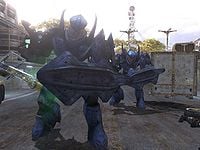
Changes from Halo 2 to Halo 3
- Hunters have even more health, and can no longer be killed with a single shot from any weapon. On Normal and Heroic difficulty it takes at least 2 shots to the weak spot from the Type-50 particle beam rifle or Sniper Rifle to kill one. Likewise, they can withstand at least a full clip and a half of assault rifle fire to the weak spot before falling.
- A Hunter's previously exposed stomach area is now protected by an armor plate. However, this can be shot off by weapons fire. Other areas of the Hunter's armor, such as the spikes and the plating around the weak spot in the back, can also be broken off by damage from gunfire.
- Hunters are even faster and more agile than in Halo 2, making it much more difficult to get behind them and shoot their weak spot.
- Hunters are no longer disoriented by explosives, but are much more vulnerable to sticky grenades. They can be killed with 2 consecutive Anskum-pattern plasma grenade or spike grenade sticks on Normal difficulty (3 grenade sticks are required on Heroic). Sticky grenades are effective even if they adhere to the Hunter's armor or shield. However, non-sticky grenades such as frag grenades and Brute shot projectiles remain fairly ineffective, doing minimal damage.
- Hunters are much rarer than in the previous two games, with a total of only 8 Hunters appearing throughout the entire game. Additionally, 2 Hunters are killed by the player while piloting a Scorpion tank, so only 6 Hunters are ever fought directly.
The Hunters in Halo 3 are even more advanced then their Halo 2 counterparts. They are even larger and much stronger, but appear less bulky.
The most notable feature of Hunters in Halo 3 is that they work, react, and function very much as a pair. Their computer AI for the game allows the Hunters to seem very closely bonded to the other, finally creating the "bond brother" idea. In the game, they also do some things simultaneously, such as strike at an enemy behind together, which further displays their connections to each other. This "bond" is most noticeable in Halo 3, but somewhat appears in the previous two games as well.
Flexible armor plating covers their previously vulnerable “stomach” areas. All melee attacks are faster and much deadlier, and these Hunters now anticipate enemies behind it and can attack them. If a grenade is thrown at a Hunter, it can strafe-jump away from the explosion.
Their armor is now more interactive, making it possible to remove portions of the hunters armor through combat. If back plating is removed, there will be a bigger target to shoot at. When the spikes fall off, small stubs of Lekgolo are left where the spike used to be. Hunters are also able to be killed by melee attacks again, as in Halo: CE. However it seems that Hunters are more vulnerable to melee attacks in Halo 3. Their Assault cannons do slightly less damage, while it appears that grenades and explosives seem to do more damage to them compared to the other two games and can kill instantly if stuck on the back or neck on Heroic or a lower difficulty. Gravity Hammers can also do a great deal of damage if hit in the exposed part of their back. Meleeing them with a Brute Shot in the back usually blows off its covering armor plating, but hitting the unprotected part instantly kills it, and strangely sends the Hunter flying 30 feet in the air. This may be a glitch or just something Bungie mistakenly left in Halo 3 after development, this can be done with other species too. Theoretically, they could be killed from the front using a very precise slice to their neck from the Energy Sword.
The most effective weapons against them are turret weapons and explosives. The Spartan Laser is the only weapon capable of scoring one shot kills on Legendary difficulty, and its accuracy makes it possibly the most useful anti-hunter weapon. It is also possible to kill a Hunter in one ram with a fast moving vehicle. The Missile Pod and Rocket Launcher can tear apart Hunters, as can dual plasma rifles if you hit them in their unprotected backs. A very effective, albeit difficult to use weapon is the energy sword, as one lunge at the unprotected back can kill it on Heroic. This is very hard to do because of the difficulty closing the distance, and the rareness of the energy sword in Halo 3's Campaign.
If a Hunter is unaware of the player or his allies, it will usually stand still. This is the perfect chance for the player to use a powerful scoped weapon such as the Sniper Rifle or an explosive weapon with slow projectiles and arc effects such as the Fuel Rod Gun, Plasma Grenade or Spike Grenade. If the player is in front of or on the side of the Hunter, he can use the explosive weapon on it, which will keep it from attacking you while you attack it. If he is on its rear, the best choice would be the scoped weapon, keeping a distance and shooting it in its exposed back. Of course, if he has the Rocket Launcher or the Spartan Laser with him, he should face the Hunter and destroy it with one shot. One way to get to a Hunters back is to have one teammate shoot the hunter in the front, (wasting ammo so use a plasma pistol, or an SMG) while the other player sneaks around the back and sticks it.
If you do not have these, it is best to stay back and use the Battle Rifle or Covenant Carbine to the vulnerable areas.
Halo 3: ODST[edit]
- Main article: Halo 3: ODST
Changes from Halo 3 to Halo 3: ODST
- A new class of Hunter with gold armor has been added in ODST. Instead of a continuous energy beam, this gold hunter fires powerful, fast-moving, exploding plasma projectiles similar to Fuel Rod Cannons.
- In ODST, the entire rear section of a Hunter's armor can be blown off by gunfire or explosives (a single grenade or Type-50 particle beam rifle shot should suffice), leaving the Hunter's entire back exposed.
- Oddly, in campaign, when a frag grenade is thrown at a hunter's feet the hunter will sometimes crouch over it, and be killed by the blast. This can be an effective way of taking them out.
Like in Halo 3, Hunters travel in pairs, but there is the odd moment when you will find a lone Hunter. This is possible in Campaign and Firefight. A pack of Hunters may consist of two regular Hunters, one blue Hunter and one gold Hunter, or two gold Hunters. Other than the color, the only difference between the blue and gold variants is the weapon they carry. Gold Hunters carry an Assault cannon similar in function to the cannon used by the Hunter in Halo: CE, but with rounds identical to fuel rod rounds in Halo 3. This means that the round will travel quickly, and with little arc, except for the gold coloration this cannon looks no different from the usual Halo 3 Assault cannon.
As in Halo 3, Hunters are most susceptible to attacks from behind, where powerful weapons such as the machine gun turret or rocket launcher will do incredible damage. Close quarters combat is now extremely dangerous because you run more slowly and can not jump as high while playing as an ODST. Sometimes, it is possible to put the Hunter into a chain of continuous melee attacks, regardless of how far away you are from it, and the trick is to get close enough to it to make it melee, then, back off and shoot its exposed area continuously, and it in turn will continuously melee. Be cautious when attempting this method, because if the Hunter lands a melee, it will do severe damage.
Combating gold Hunters is more risky at long range, because their fuel rod projectiles travel faster, can be fired quite quickly in succession, and carry massive splash damage. This makes them more formidable against vehicles. It is recommended that the player weaves in such a way that the Hunter will constantly have to adjust its aim. Fighting both a blue and gold variant at the same time is also tricky, because you have two different types of attacks to dodge. In firefight, teamwork is essential in taking down the Hunter, the ideal position being one person in front of the hunter, getting its attention, while another person positions himself behind it, with a clear shot at the exposed spots. Another good strategy when facing two Hunters, is to have one stand in front of the other. When the Hunter in the rear fires, he will injure the Hunter in front of him.
Another less well known tactic involves forcing the Hunter to jump off of the map. This can be done if you lead a hunter to an area with a bottomless pit (this only works on the maps Windward, Chasm Ten, and Alpha Site) and throw a grenade at their feet. With tough luck on, the Hunter will attempt to dodge the grenade and jump off of the floor and into the pit, killing itself. Grenade placement must be very precise, and in an area where the hunter will jump off of the map (to the side of the hunter if the hunter is right beside the pit).
It is always good to preserve Fuel Rod and Rocket Launcher ammunition in anticipation of Hunters. They will usually appear at least once during a set. These weapons are the most effective at Hunter killing, and it is possible to kill a Hunter in less than five seconds if well equipped. Before the mythic and tilt skulls are activated it is a good idea to use sticky grenades, unlike in Halo 3 firebombs have almost no effect.
Halo Wars[edit]
- Main article: Halo Wars
Hunters always appear in pairs and occupy a strong anti-vehicle role.[2] Armed with a Fuel Rod Gun, they can deliver heavy damage to UNSC ground vehicles. When one Hunter falls, it becomes much easier to kill the remaining one.[3] As aforementioned, they are mainly anti-vehicle: they'll get rid of Warthogs, Cobras, Wolverines, Gremlins and early Scorpion versions pretty fast. However they're ineffective against infantry, and useless against aircraft. Can be trained inside the Hall for 250 resources, a population of 2, and have several upgrades:
- Bonded Shield- Adds the iconic hunter shield which deflects projectiles. 200 resources and a tech level of 1.
- Spirit Bond- Increases damage output while both hunters in bonded pair are alive. 400 resources and a tech level of 2.
- Assault Beam- Mortar-like Fuel rod Cannon upgrades to Beam version for sustained, yet heavy amount of damage. 700 resources and a tech level of 3.
Halo: Reach[edit]
- Main article: Halo: Reach
Changes from Halo 3: ODST to Halo: Reach
- Hunters receive a considerable boost in health and armor and cannot be killed in a single shot with any weapon.
- A heavy weapon such as Rocket launcher, with a lucky shot can kill the Hunters by expending an entire clip right into the head.
- On a very rare occasion, a Hunter can be killed in one shot with a well-placed Rocket launcher shot, especially at the head without raising the guard.
- Shields negate damage from every weapon including explosive ones.
- The Assault cannon is similar to its original appearance in Halo: Combat Evolved, firing an incendiary blob of gel that explodes on impact.
- Armor is more detailed and have small lights near their face.
- The M6/V Spartan Laser is a very effective weapon, scoring a one-hit kill if aimed correctly.
- The Energy Sword is highly effective against Hunters, as each slash will stun them and a slash to the back kills them instantly on any difficulty.
- The M45 shotgun can be used effectively against single Hunters in close quarters situations if the player circles around them while aiming for their weak spots.
Hunters are even more dangerous than in previous games. Their Assault cannon is similar to the one for Halo: Combat Evolved. They will rarely aim directly at the player, instead shooting at their feet, relying more on the splash damage then the actual projectile. Melee attacks by Hunters are much faster and more powerful, making them much more difficult to engage in close quarters. In addition Armor Lock is disabled if struck by a Hunter. Hunters will also use their shields more efficiently than in previous games. They will often use their shield to protect their exposed midsection and necks when attacked, making attacks on the back section the only viable option to kill them. However attacks on their backs are difficult to accomplish if detected by the Hunter due to their high speed. Their increased health makes successful attacks on their back less damaging. They display much greater resistance to most forms of damage, capable of surviving rockets and Spartan Laser hits head-on on Heroic difficulty and higher. They are encountered rarely, but they are extremely dangerous on any difficulty. Furthermore, with Reach's revamped physics system, splattering them is near impossible, unlike in previous games.
Halo 4[edit]
- Main article: Halo 4
Changes from Halo: Reach to Halo 4
- Hunters are slightly more vulnerable to damage.
- The Energy Sword is less effective, as only a hit to an unarmored section kills them. This can drain a significant amount of battery if not done correctly. It still works well in comparison to other tactics.
- In the level Requiem you can spawn four Hunters at the terminus by going to the seaside platform on the middle level, this also double spawns all the enemies past the sword elite.[4]
Halo 5: Guardians[edit]
- Main article: Halo 5: Guardians
Changes from Halo 4 to Halo 5: Guardians
- Mgalekgolo are far more lethal and durable than their predecessors. This makes them especially dangerous on Legendary difficulty.
- Their melee strikes are now nearly impossible to dodge.
- They also utilize both firing modes of their assault cannons: its rapid-firing of green tracking plasma shots, and its default.
- When one is killed, the remaining Mgalekgolo will enter a berserk mode, during which it will start emitting green electrical sparks and will fire its assault cannon's close range attack twice in each volley.
- Warzone Firefight introduces Legendary and Mythic versions of Mgalekgolo, in red and white armor respectively. The Mythic Mgalekgolo have more health and do more damage, and fire three sequential fuel rod shots at the player, which can be dangerous even to armored vehicles.
Hunters are first encountered in Blue Team, as soon as the Spartans of Blue Team enter the laboratory. They then appear in most subsequent levels featuring Covenant enemies, and a lone Hunter can even be found in Swords of Sanghelios.
Halo Wars 2[edit]
- Main article: Halo Wars 2
Hunters[edit]
- Info: Anti-Vehicle, Heavily armored, Cannot attack air
- Tier: 2
- Cost: Population 5, Supplies 140, Power 180
- Hunter upgrade: Beam Cannon
- Info: Increased damage, Beam cannon does damage along trajectory
- Tier: 3
- Cost: Supplies 0, Power 900
Hunters can be built at the Raid Camp by every Banished leader, and are once again anti-vehicle units. Hunters perform well against vehicles, okay against structures, poorly against infantry, and cannot attack aircraft. Once the Beam Cannon upgrade has been researched Hunters will perform okay against infantry. In Blitz Hunters cost 40 energy while Ironclad Hunters cost 60 energy and Scarred Hunters cost 100 energy.
Halo Infinite[edit]
- Main article: Halo Infinite
Changes from Halo 5: Guardians to Halo Infinite
- Hunters now come in two ranks: Standard and Ardent.
- Ardent Hunters are stronger and deadlier than standard Hunters, and are some of the toughest non-boss enemies in the game.
- If the subtitles are on, the otherwise unintelligible noises Hunters make appear as [Aggressive groan], [Idle groaning], [Proud growls], [Excited threatening growl], [Angry threatening roar], etc.
 This section needs expansion. You can help Halopedia by expanding it.
This section needs expansion. You can help Halopedia by expanding it.
Hunters are first encountered in the main campaign mission Spire. A pair of standard Hunters guard the gravity lift at the base of the Reformation Spire and must be defeated before the player can reactivate the lift. Standard Hunters are encountered again in Pelican Down, The Sequence, Nexus, and The Road. Ardent Hunters are encountered in House of Reckoning and Silent Auditorium.
